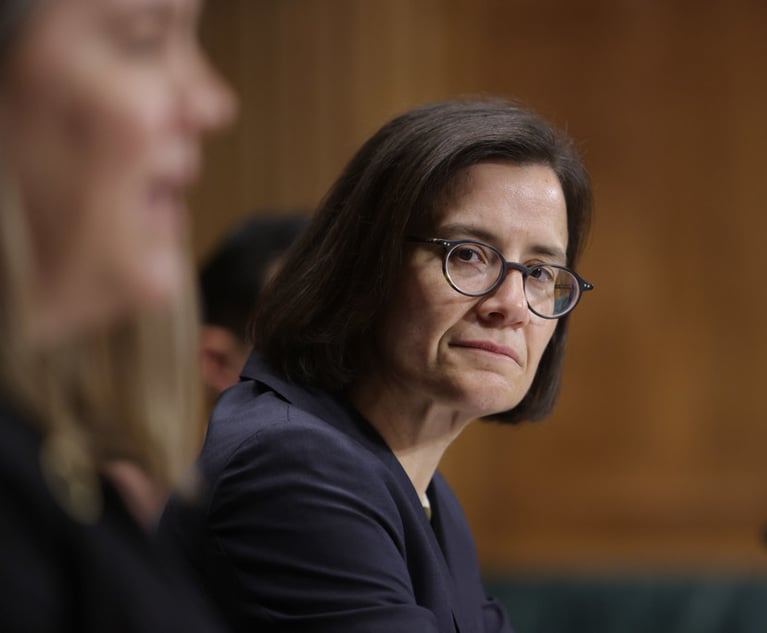Litigation Department of the Year, Consumer Class Actions: Gibson, Dunn & Crutcher
This past year on the consumer class actions front, lawyers at Gibson, Dunn & Crutcher beat back class claims that Yamaha boat motors were prematurely…
November 14, 2017 at 01:05 PM
28 minute read

This past year on the consumer class actions front, lawyers at Gibson, Dunn & Crutcher beat back class claims that Yamaha boat motors were prematurely corroding, and that the antilock braking systems of certain Toyota Prius models were defective. The firm also got an early knockout for Aetna Inc. affiliates in a coverage dispute challenging the way they handled medical payments option for auto insurance policies. Christopher Chorba and Theane Evangelis, co-chairs of the firm's class actions practice group, recently responded to a round of questions from The Recorder about Gibson's approach to class action defense.
The Recorder: What were the unique challenges presented by the matters the firm is being recognized for, and how did your teams working those cases overcome them?
Theane Evangelis: As these cases demonstrate, we have developed aggressive strategies for defeating class actions before they ever get off the ground. We have secured the early dismissal of putative nationwide class actions for our clients, while other defendants facing similar lawsuits have been forced to litigate through expensive discovery and uncertain class-certification and trial proceedings.
In our representation for Yamaha, we overcame numerous hurdles to secure an early dismissal on the pleadings and a published, precedential Ninth Circuit opinion upholding the dismissal. Plaintiffs had alleged that certain Yamaha boat motors were susceptible to premature corrosion, and sued under 12 different states' consumer protection statutes. The litigation involved significant difficulties, including plaintiffs' heavy reliance on an article in a national boating publication that purported to expose the alleged corrosion defect and disparage the Yamaha motors at issue. Second, various plaintiffs initiated lawsuits throughout the country, which were assigned to different judges and created a substantial risk of costly litigation on numerous fronts. Third, the myriad state laws at issue required Gibson Dunn to develop unifying themes and legal arguments if Yamaha had any chance of defeating the lawsuits in one swoop. Finally, plaintiffs sued both the U.S. distributor (Yamaha Motor Corp. U.S.A.) and the Japanese manufacturer (Yamaha Motor Co.). Yamaha hoped to dismiss the Japanese entity for lack of personal jurisdiction, but those efforts were complicated by a very dynamic legal landscape. Specifically, while the parties were briefing personal jurisdiction, the courts were grappling with the contours of recent U.S. Supreme Court decisions, including Daimler AG v. Bauman, 134 S. Ct. 746 (2014). A key issue was whether plaintiffs could “impute” the jurisdiction contacts from Yamaha Motor Corp. USA to the Japanese entity—an issue plaintiffs argued was left open by Daimler.
Despite these challenges, we secured a complete dismissal with prejudice on the merits, and a dismissal of the Japanese entity for lack of personal jurisdiction. We were able to achieve an efficient and effective result for Yamaha by successfully transferring and consolidating several of the lawsuits before the same California federal judge. We then developed unifying themes and legal arguments, focusing on the fact that no plaintiff had alleged any issues with his or her motor during the warranty period. One of the central defenses throughout the case (pioneered by Gibson Dunn) was that the plaintiffs could not use various states' consumer protection laws to evade the terms of their warranty, particularly where, as here, the alleged defect did not pose any safety risk to consumers.
TR: What would you say is the trait of your litigators and your litigation department that keeps clients coming back—especially when they face class claims?
Christopher Chorba: Our track record and proven expertise is what keeps clients coming back. Our clients entrust us with defending their most significant class actions because our firm has defeated many of the most significant class actions in recent years. Our unrivaled experience and judgment in this area enable us to attack enterprise-threatening liability claims systematically, efficiently, economically and creatively.
TR: A prospective client with a crisis calls and asks why your team should be retained. What is your answer?
CC: No firm has amassed a stronger record in defeating high-stakes class actions than Gibson Dunn—whether it's securing dismissals on the pleadings (before burdensome discovery), defeating class certification, winning at trial, or securing precedent-setting U.S. Supreme Court wins, such as Walmart v. Dukes, Comcast v. Behrend, and Standard Fire v. Knowles. We have more than 200 attorneys in our Class Actions Practice Group across the country, and our trial and appellate teams work seamlessly together to attack cases from the outset through final judgment.
It's a challenging litigation market, with flat or declining demand, and rate pressures. From a business perspective, what does it take for a litigation department to succeed in this environment?
TE: Excellence and efficiency—the ability to consistently deliver top-quality work and results cost-effectively.
All objective measures indicate that class action filings are increasing at a greater rate, and that more of these actions present significant exposure to our clients. By consistently delivering for our clients in their most important cases, the firm is able to both attract new clients and to get new matters from existing and past clients. We find that clients are willing to recognize the value the firm brings to these important matters.
What is the firm doing to train up the next generation of litigators in your ranks?
CC: While it is true in general that fewer cases are proceeding to trial, because of the nature and volume of cases that the firm handles, Gibson Dunn continues to try substantial cases every year, and this year is no different. Associates working on those cases will often have the benefit of trial experience, sometimes arguing motions and sometimes examining witnesses. We also pride ourselves on being “thought leaders” in class actions. As part of this effort, we encourage our associates to write articles and take advantage of speaking opportunities on these issues. The firm also maintains a robust pro bono practice in which trials are more common and associates are often lead trial counsel. In cases that do not go to trial, the firm tries to get associates experience appearing in court at various hearings and arguing motions or appeals. Our goal is, whenever possible, to provide our associates with the training and experience they will need to be tomorrow's litigation stars.
How is your department harnessing technology to work more efficiently?
TE: With cutting-edge technology, the firm believes that its litigators are able to operate as efficiently as possible even under difficult circumstances and in the most complex of cases. We also use a wide variety of software and databases to assist us in maintaining and organizing all aspects of our cases as we head to trial. This saves countless hours of analysis since things can be done once for the benefit of the entire team, and everyone can add their own value to the work.

This past year on the consumer class actions front, lawyers at
The Recorder: What were the unique challenges presented by the matters the firm is being recognized for, and how did your teams working those cases overcome them?
Theane Evangelis: As these cases demonstrate, we have developed aggressive strategies for defeating class actions before they ever get off the ground. We have secured the early dismissal of putative nationwide class actions for our clients, while other defendants facing similar lawsuits have been forced to litigate through expensive discovery and uncertain class-certification and trial proceedings.
In our representation for Yamaha, we overcame numerous hurdles to secure an early dismissal on the pleadings and a published, precedential Ninth Circuit opinion upholding the dismissal. Plaintiffs had alleged that certain Yamaha boat motors were susceptible to premature corrosion, and sued under 12 different states' consumer protection statutes. The litigation involved significant difficulties, including plaintiffs' heavy reliance on an article in a national boating publication that purported to expose the alleged corrosion defect and disparage the Yamaha motors at issue. Second, various plaintiffs initiated lawsuits throughout the country, which were assigned to different judges and created a substantial risk of costly litigation on numerous fronts. Third, the myriad state laws at issue required
Despite these challenges, we secured a complete dismissal with prejudice on the merits, and a dismissal of the Japanese entity for lack of personal jurisdiction. We were able to achieve an efficient and effective result for Yamaha by successfully transferring and consolidating several of the lawsuits before the same California federal judge. We then developed unifying themes and legal arguments, focusing on the fact that no plaintiff had alleged any issues with his or her motor during the warranty period. One of the central defenses throughout the case (pioneered by
TR: What would you say is the trait of your litigators and your litigation department that keeps clients coming back—especially when they face class claims?
Christopher Chorba: Our track record and proven expertise is what keeps clients coming back. Our clients entrust us with defending their most significant class actions because our firm has defeated many of the most significant class actions in recent years. Our unrivaled experience and judgment in this area enable us to attack enterprise-threatening liability claims systematically, efficiently, economically and creatively.
TR: A prospective client with a crisis calls and asks why your team should be retained. What is your answer?
CC: No firm has amassed a stronger record in defeating high-stakes class actions than
It's a challenging litigation market, with flat or declining demand, and rate pressures. From a business perspective, what does it take for a litigation department to succeed in this environment?
TE: Excellence and efficiency—the ability to consistently deliver top-quality work and results cost-effectively.
All objective measures indicate that class action filings are increasing at a greater rate, and that more of these actions present significant exposure to our clients. By consistently delivering for our clients in their most important cases, the firm is able to both attract new clients and to get new matters from existing and past clients. We find that clients are willing to recognize the value the firm brings to these important matters.
What is the firm doing to train up the next generation of litigators in your ranks?
CC: While it is true in general that fewer cases are proceeding to trial, because of the nature and volume of cases that the firm handles,
How is your department harnessing technology to work more efficiently?
TE: With cutting-edge technology, the firm believes that its litigators are able to operate as efficiently as possible even under difficult circumstances and in the most complex of cases. We also use a wide variety of software and databases to assist us in maintaining and organizing all aspects of our cases as we head to trial. This saves countless hours of analysis since things can be done once for the benefit of the entire team, and everyone can add their own value to the work.
This content has been archived. It is available through our partners, LexisNexis® and Bloomberg Law.
To view this content, please continue to their sites.
Not a Lexis Subscriber?
Subscribe Now
Not a Bloomberg Law Subscriber?
Subscribe Now
NOT FOR REPRINT
© 2025 ALM Global, LLC, All Rights Reserved. Request academic re-use from www.copyright.com. All other uses, submit a request to [email protected]. For more information visit Asset & Logo Licensing.
You Might Like
View All

Lawsuits, AI Accuracy and Debt: Legal Tech Companies that Ran Into Trouble in 2024

‘Not A Kindergarten Teacher’: Judge Blasts Keller Postman, Jenner & Block, in Mass Arb Dispute
6 minute read
Trending Stories
Who Got The Work
Michael G. Bongiorno, Andrew Scott Dulberg and Elizabeth E. Driscoll from Wilmer Cutler Pickering Hale and Dorr have stepped in to represent Symbotic Inc., an A.I.-enabled technology platform that focuses on increasing supply chain efficiency, and other defendants in a pending shareholder derivative lawsuit. The case, filed Oct. 2 in Massachusetts District Court by the Brown Law Firm on behalf of Stephen Austen, accuses certain officers and directors of misleading investors in regard to Symbotic's potential for margin growth by failing to disclose that the company was not equipped to timely deploy its systems or manage expenses through project delays. The case, assigned to U.S. District Judge Nathaniel M. Gorton, is 1:24-cv-12522, Austen v. Cohen et al.
Who Got The Work
Edmund Polubinski and Marie Killmond of Davis Polk & Wardwell have entered appearances for data platform software development company MongoDB and other defendants in a pending shareholder derivative lawsuit. The action, filed Oct. 7 in New York Southern District Court by the Brown Law Firm, accuses the company's directors and/or officers of falsely expressing confidence in the company’s restructuring of its sales incentive plan and downplaying the severity of decreases in its upfront commitments. The case is 1:24-cv-07594, Roy v. Ittycheria et al.
Who Got The Work
Amy O. Bruchs and Kurt F. Ellison of Michael Best & Friedrich have entered appearances for Epic Systems Corp. in a pending employment discrimination lawsuit. The suit was filed Sept. 7 in Wisconsin Western District Court by Levine Eisberner LLC and Siri & Glimstad on behalf of a project manager who claims that he was wrongfully terminated after applying for a religious exemption to the defendant's COVID-19 vaccine mandate. The case, assigned to U.S. Magistrate Judge Anita Marie Boor, is 3:24-cv-00630, Secker, Nathan v. Epic Systems Corporation.
Who Got The Work
David X. Sullivan, Thomas J. Finn and Gregory A. Hall from McCarter & English have entered appearances for Sunrun Installation Services in a pending civil rights lawsuit. The complaint was filed Sept. 4 in Connecticut District Court by attorney Robert M. Berke on behalf of former employee George Edward Steins, who was arrested and charged with employing an unregistered home improvement salesperson. The complaint alleges that had Sunrun informed the Connecticut Department of Consumer Protection that the plaintiff's employment had ended in 2017 and that he no longer held Sunrun's home improvement contractor license, he would not have been hit with charges, which were dismissed in May 2024. The case, assigned to U.S. District Judge Jeffrey A. Meyer, is 3:24-cv-01423, Steins v. Sunrun, Inc. et al.
Who Got The Work
Greenberg Traurig shareholder Joshua L. Raskin has entered an appearance for boohoo.com UK Ltd. in a pending patent infringement lawsuit. The suit, filed Sept. 3 in Texas Eastern District Court by Rozier Hardt McDonough on behalf of Alto Dynamics, asserts five patents related to an online shopping platform. The case, assigned to U.S. District Judge Rodney Gilstrap, is 2:24-cv-00719, Alto Dynamics, LLC v. boohoo.com UK Limited.
Featured Firms
Law Offices of Gary Martin Hays & Associates, P.C.
(470) 294-1674
Law Offices of Mark E. Salomone
(857) 444-6468
Smith & Hassler
(713) 739-1250






